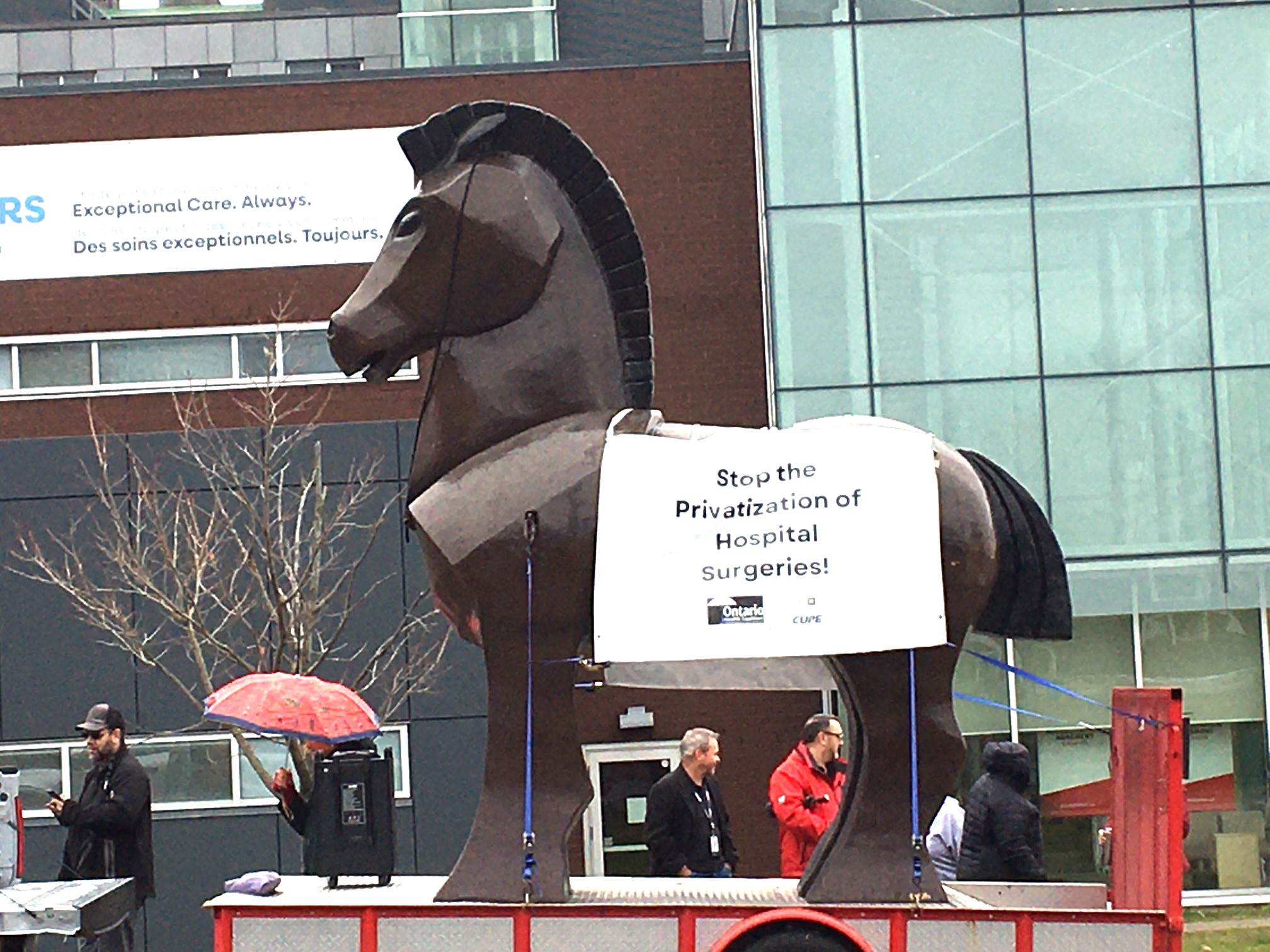Beware the Trojan Horse: How Doug Ford’s Healthcare Plan Is Undermining Ontario’s Public System
On Monday, November 4, 2024, I attended a healthcare protest in front of the Cornwall Community Hospital featuring a striking symbol of public resistance: a 15-foot-high metal and resin Trojan Horse. This towering figure, a vivid reminder of the Greek tale of deceit and hidden agendas, is driven from town to town to alert Ontarians to the dangers embedded in Doug Ford’s healthcare privatization plans. The Trojan Horse campaign could not be more fitting as a warning to Ontario communities about what lies ahead if Ford’s plans go unchallenged.
Doug Ford’s healthcare strategy is presented as an innovative solution to Ontario’s public healthcare issues, promising reduced wait times, improved service quality, and relief for overcrowded hospitals. But like the original Trojan Horse, what’s hidden beneath the surface is a different story. If we let this “gift” roll past our gates, it will dismantle the very system that Ontarians have invested in and trusted for generations.
The Trojan Horse Plan: Disguised in the Promise of “Improvement”
On the surface, Ford’s push for privatization appears to be a harmless and, indeed, beneficial solution to the province’s healthcare woes. But as we know, the Trojan Horse of yore was no ordinary gift, and neither are these so-called improvements. Ford’s stealth approach blends systematic starvation of the public system over the years with a quiet shift of healthcare services toward private, for-profit providers at taxpayers’ expense.
So let’s look at the “gift”.
In a public system, the government uses our taxes to pay for public hospitals, doctors, nurses, other staff and equipment.
In a privatized scheme, the government redirects part of our taxes to private healthcare companies in addition to what they get from private investors.
The public system allows all citizens covered under public health insurance (OHIP) equal access to healthcare services. When adequately funded, public healthcare can offer its services promptly and with excellent quality assurance.
Private clinics and facilities use a mix of public monies and private funds to offer healthcare services that might not be fully covered under public insurance. Often, these clinics offer “priority” or enhanced services for a fee, creating a two-tier system where those who pay more get faster or more exclusive care.
This could include:
- Faster access to diagnostic tests and procedures
- Enhanced comfort and amenities
- Comprehensive “executive” health checkups
- Alternative and holistic treatments
That sounds nice. So why do so many have problems with it?
- Private clinics use public tax dollars taken from the public system
- Private clinics use facilities paid for by the public system
- Private clinics do not magically increase the number of available doctors and nurses. Instead, they use our limited supply of doctors, nurses, and other staff, removing needed labour from the public system and weakening its ability to provide timely services.
- Private clinic services can perform procedures the public healthcare system pays for. The ick is that they charge more to extract profit. In many cases, they are guilty of charging both the private user and the public system.
- The patient must pay out of pocket for private healthcare through direct payment, private insurance, healthcare loans etc.
Note on private insurers. They are “for-profit” businesses. They find ways to make profits by:
- charging higher premiums
- limiting coverage with narrow plans
- establishing deductibles, co-pays, and co-insurance
- delaying or denying claims
- negotiating lower rates with healthcare providers
- limiting access to high-cost drugs and treatments
- avoiding high-risk customers
So, with this in mind, why would a government want to be involved in privatizing healthcare? What’s in it for them?
“Savings”: By outsourcing services to private companies, the government can reduce its immediate financial responsibility for staffing, equipment, and facility upkeep. In the short term, this looks like “savings” on government books, even though your costs increase.
Responsibility: When the government transfers services to private hands, it also shifts accountability. Private companies can bear the responsibility if a service doesn’t meet quality standards or wait times don’t improve, while the government is blameless.
Political Power: Private healthcare companies and investors profit from privatization and many support political parties or candidates that favour this approach. Campaign donations, lobbying, and other political influence can lead to policies that benefit these private players, at the expense of the public’s best interest.
“Economic Growth”: When private clinics and facilities are built, they can create jobs and stimulate private investment. This allows the government to say it is boosting “economic growth” through private healthcare ventures. This can sound appealing to voters concerned with economic indicators, even when it doesn’t improve healthcare quality or accessibility.
“Innovation”: Some government officials genuinely believe that the private sector is more efficient and innovative than the public sector. They may feel that competition among private providers will drive up quality and bring down costs. However, healthcare doesn’t behave like typical markets; competition usually leads to profit-seeking behaviours, creating a system that serves those who can pay rather than guaranteeing universal access.
The Trojan Horse Revealed
Tax-conscious voters love to support politicians who promise tax cuts. Who doesn’t want a tax break? But the hidden price is steep: essential services, like healthcare, become underfunded or siphoned into private hands, leaving patients to bear the burden. The public system weakens, and what was once accessible to all becomes a privilege for those who can pay.
In the short term, these moves may look like savings, but the long-term cost is borne by all of us—patients left with bigger bills and fewer choices, and taxpayers forced to fund a fractured system.
Doug Ford’s ‘gift’ might seem like a blessing wrapped in tax cuts and efficiency, but don’t be fooled. This is no cute pony—it’s a Trojan Horse and it’s loaded with costs we can’t afford.





